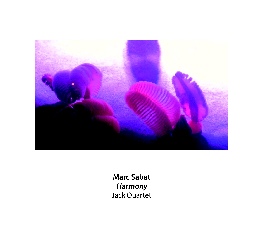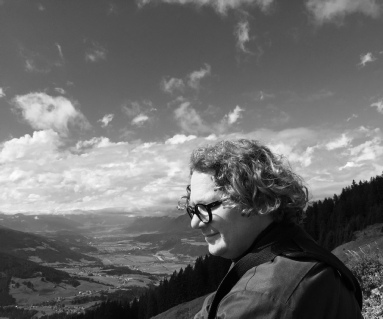Another Timbre TimHarrisonbre

at109 Marc Sabat ‘Harmony’ Canadian Composers Series #5
Played by the Jack Quartet
1. ‘Euler Lattice Spirals Scenery’ (2011) 33:02 youtube extract
2. ‘Claudius Ptolemy’ (2008) 8:00
3. ‘Jean Philippe Rameau’ (2012) 22:39 youtube extract
Chamber music for strings using Just Intonation tuning, superbly played by the Jack Quartet.
Marc Sabat
The fifth CD in the Canadian Composers Series is also the debut appearance on Another Timbre by the Jack Quartet. It features chamber music for strings by the Berlin-based composer Marc Sabat, whose compositions explore the world of Just Intonation. But, as Nick Storring argues in the booklet accompanying the Canadian Composers Series of CDs, “to fixate upon this aspect of his music conceals at least half of what makes it so beguiling and beautiful. From an aural perspective, what is most salient about his work is not the system itself but his fluency within it. Part of this is attributable to his deep insight and compassion surrounding performance. Prior to his shift from to Toronto to Berlin, Sabat was revered as a violinist, and in his Euler Lattice Spirals Scenery quartet one hears the fruits of his tireless exploration of pitch. But his music never comes across as a dry academic study. Rather his rich treatment of the string quartet as medium brings the listener into close proximity with the palpable joy Sabat experiences in discovering these sonorities. It's anchored in a reflective, unhurried temporality, but full of radiant blossomings of sound, wild sparkling eruptions in the instruments' uppermost registers.”
In the following extract from his interview in the Canadian Composers Series booklet, Marc Sabat talks about his early musical discoveries and what first drew him towards alternative tuning systems:
“Living in a small town, in the years before the internet came and flattened out the earth, I spent many hours borrowing recordings, LPs, cassettes, later CDs and videos, from the local library, and gradually I amassed a substantial collection of records and scores, studying over headphones, reading interviews with composers and artists’ writings. Chance encounters with fascinating books, wandering through a section of the library stacks, often led to new and unexpected discoveries.
What and where did you study at university?
I went to the University of Toronto, where I studied violin, composition, and mathematics, completing a BA in 1986. I followed this with a Master’s at the Juilliard School in New York (1988) and then two years of string quartet playing in Banff and St. John’s Newfoundland. But I decided not to pursue classical performing and began focussing on auto-didactic explorations of just intonation, improvisation and electronic music. A big inspiration came by a chance discovery in the St. John’s university library: a signed copy, virtually untouched, of Harry Partch’s Genesis of a Music, in which he described his own ‘new beginnings’ exploring the adapted viola. I was enthralled, and it made perfect sense to me.
As I got to know the intervals and harmonies Partch described, making my own colour-coded paper fingerboards, I could imagine the possibility, the sound, of an incredible world of new harmonies not yet heard, and this led me back to following a path as a composer. The expressionism and abstraction of much post-war European new music never appealed to me; it remained intangible and divorced from sensory experiences I could relate to. But Partch’s theoretical exposition of microtonally extended just intonation seemed to me like something really new, unexplored, abstract, and sensual, all in one.
I moved to Montréal in 1990 and briefly studied computer music as a special student at McGill. But I quickly lost interest in the academic music scene, and worked instead on improvised performance projects and collaborations with my filmmaker/artist brother Peter. Attending many concerts of experimental music, I heard Malcolm Goldstein play and asked if we could meet; in our session he introduced me to Jim Tenney’s work with just intonation. Soon after, during a week-long workshop with Malcolm in Vermont, I composed the first piece which is still part of my catalogue, a kind of new ‘Opus 1’, an exploration of Harry Partch's utonal subharmonic chord, played on radically retuned violin and viola in just intonation, called Three Chorales for Harry Partch.
That interest in just intonation has been fundamental to the music you have composed ever since. Why is it so important to you?
I think the reason I became fascinated by the intricate tonal logic of Just Intonation was that it offered a precise description of sound phenomena which I was already hearing, experiencing, while listening closely to my violin. It was clear to me that there were a diversity of intervals that could be clearly distinguished by listening to their sonority, and that these intervals deviated quite radically, in some cases, from the pitches of the piano or of notes written up in the existing Western European notation.
The interactions of tones produce patterns of texture which are like characteristic signatures, and these distinctive sounds require precise variations of intonation to become clear. Since ancient times composers and theorists have used proportions (or more accurately, ratios of frequency) to define intervals and describe the relationships which connect tones melodically, harmonically, contrapuntally, timbrally. Partch’s ‘language of ratios’ and ‘tonality diamond’ opened up the concept of a multidimensional harmonic space, more precisely described in writings by Ben Johnston and James Tenney, which has given me a way of entering the world of harmony.
I began these explorations by writing several pieces about slow motion sound, sometimes mixing rough, distorted noisy tone with sustained pitches, inspired by writings by Steve Reich (I don’t think I’d heard much Scelsi yet at that point...). I’ve always been fascinated with slow chorales, and many of my pieces are built around some kind of variation of a chord sequence or cantus firmus. As I began to investigate the possibility of moving around in harmonic space, connecting pitch aggregates by common tones, I realised that I’d need to develop a suitable microtonal notation.”
You can read the whole of Marc Sabat’s interview in the Canadian Composers Series booklet. The booklet comes free with any order of two or more of the Canadian series CDs, or you can order it separately below for £4.

Marc Sabat Photo by Natalie Pfeiffer
for special offer of all 10 Canadian CDs go here
Reviews
* see also reviews of the Canadian Composers Series here
“There might be radiant upper partials shedding gleam, but Marc Sabat’s music also knows infinite degrees of dissonance. The works on this recording, beautifully presented by the JACK Quartet in its original lineup, venture into what the title of the main item describes as ‘Euler Lattice Spirals Scenery’ – a landscape of subtly or starkly different microtonal gradations of justly tuned untempered intervals in harmonies that emerge from one another by way of strange routes (and strange roots), with often this sheen high in the sky. These harmonies may be spiralling within an ‘Euler Lattice’ – a network of notes defined by ratios using integers up to 5, as described first by Leonhard Euler – but what one experiences is continuous flow, which will very occasionally be startlingly interrupted, or seem to resolve momentarily in an unuaually lustrous common chord, glistening from the concurrence of partials, or through lengthy periods return on itself.
The music is nearly always slow. In an interview, the composer speaks of how we may be living through a musical epoch when ‘dormant properties gently re-emerge in a new light’, and his work seems to actualize this happening, the gentleness, the re-emergence and the light. (The record comes naked into the world; the interview is contained in a separate book supplying similarly informative interviews with all ten composers in this Canadian Composers Series.) Euler Lattice Spirals Scenery opens with a Preludio, subtitled ‘Quintes justes’, that offers a seamless tour d’horizon. That done, the piece moves on to a pair of big homages bookended by a slim pair of ‘Pythagras Drawings’, seemingly inversions of one another. The first homage, to Claude Vivier, has some feeling of fanfare and medieval music, occluded by a curtain; the second, to Ben Johnston, similarly sounds something like a long disguise of Bachian formulae and cadences. In this world, however, you have to let go of your bearings; otherwise, you might miss the music.
Sabat bravely records that it was a critical comment from Johnston that made him reconsider the place of expression in his music. Even so, his quartets – another is included, Rameau, in four movements that seem to be taking the same course in different ways – remain abstract, and welcomely so, with nothing pushing the music, no passion overspent. They speak for themselves, express for themselves an intense calm, a resilient rightness.”
Paul Griffiths, disgwylfa
“A long time fixture on the Toronto scene as a string performer, improviser, and composer, Marc Sabat now resides in Berlin. However, he has taken his experimental penchant for tuning systems with him, writing in extended just intonation with a fluency that rivals Harry Partch and Ben Johnston’s own explorations of pitch. On the CD Harmony, JACK Quartet plays two quartets and a duo with rapt attention to the detailed nuances of Sabat’s pitch language and a keen sense of its corresponding flowing rhythms.
Euler Lattice Spirals Scenery (2011) is a five movement work that name checks various elements and personages of the intonation studies milieu. The first movement, Preludio, is subtitled “Les Quintes Justes” and it indeed does deal with sustained pure fifths in evocative fashion. Two of the movements, numbers two and five respectively, are titled Pythagoras Drawing. Movements three and four are each dedicated to a different composer who has been influential on Sabat; they are titled Harmonium for Claude Vivier and Harmonium for Ben Johnston. Each successive movement sends us a little further into the dark forest of dissonant overtones that accumulate on top of “Les Quintes Justes.” Thus, the entire piece can be seen as gradually revealing the compass of Sabat’s pitch palette.
Claudius Ptolemy (2008) is a duo, played by JACK violinist Christopher Otto and cellist Kevin McFarland (note: Jay Campbell now plays with the group). Open string double stops as well as dissonant intervals, harmonics, and ambling melodies combine in this adagio essay to make a fresh-sounding conglomeration of familiar playing techniques. The aforementioned “ambling affect” is one that Sabat shares with a number of his Canadian colleagues, not least Linda Catlin Smith, whose volume in the Canadian Composer Series (#1) appeared as a review here earlier in 2017. The final work on the Sabat CD is named after another important music theorist: Jean-Philippe Rameau (2012). Here the simultaneities are particularly fetching, with double-stops from multiple quartet members overlapping into beautiful chords. In one of his treatises( from 1737), Rameau struggled to describe the consonant and dissonant properties of just intonation: Sabat’s Rameau lays it out for all to hear with abundant clarity. “
Christian Carey, Sequenza 21